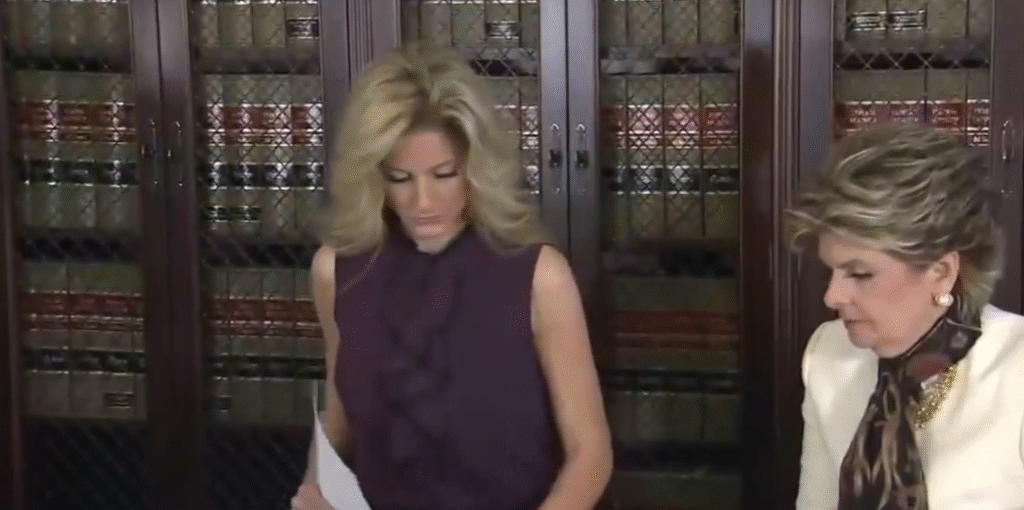Misinformation can become remarkably effective when it mimics the rhythm of truth, as the Kelly Feuer Settlement story eerily illustrates. With startling speed, a digital table spread that Donald Trump had paid a $1 million settlement to a fictitious 12-year-old girl named Kelly Feuer. It looked visually plausible, dressed up in the style of courtroom records, but there is no evidence of such a case anywhere in authenticated legal archives.
Even wary readers were drawn in by the post’s appearance of legitimacy, which was created by using dollar amounts and language that sounded legal. The human mind is drawn to organized evidence, especially when it is confronted with indignation; even when a table of numbers is completely untrue, it may seem remarkably clear. This trust in visual order was precisely what allowed the hoax to flourish.
The creator stitched pieces of real scandals—Trump’s connections to Jeffrey Epstein, previous lawsuits, and confirmed misconduct cases—into a fake tapestry while posting under the alias Vireon Aeth, who was later revealed to be Ben Jorisch. By placing “Kelly Feuer” next to made-up victims like “Charles Bacon” and “Rebecca Conway,” the story was given a pseudo-official cadence that readers unconsciously identify with accountability. Its deception was especially creative, combining emotional manipulation with data formatting.
Kelly Feuer – Case Information and Background
| Field | Details |
|---|---|
| Full Name | Kelly Feuer |
| Claimed Age in Allegation | 12 years old |
| Alleged Incident Year | 1994 |
| Claimed Settlement Amount | $1 million |
| Alleged Involvement | Donald J. Trump (as claimed in viral meme) |
| Authentic Legal Record | None found in federal or state court databases |
| Image Used in Hoax | Childhood photo of actress Nadia Bjorlin (used without consent) |
| Origin of Claim | Viral meme shared on X (formerly Twitter) |
| Primary Source of Disinformation | User @BenJorisch (alias Vireon Aeth) |
| Verified Fact-Check Sources | PolitiFact, Snopes, PBS News |
| Fact-Check Verdict | Entirely fabricated; no evidence of any lawsuit or settlement |
| Connection to Real Events | False adaptation of the withdrawn 2016 “Katie Johnson” lawsuit involving Trump and Epstein |
| Public Impact | Viral misinformation shared across political and conspiracy groups |
| Authentic Reference Link | https://www.politifact.com/factchecks/2024/jul/12/no-proof-of-settlements-by-donald-trump-for-child-sex-crimes/ |

PolitiFact and Snopes fact-checkers swiftly reacted, pointing out that the Feuer claim was not only false but completely made up. Tragically, the post’s attached image was that of actress Nadia Bjorlin, who posted a childhood photo online as a family remembrance years ago. It was heartbreaking to see it reframed as “proof” of abuse, and it was particularly eye-opening to see how easily innocence can be used as a weapon in digital narratives.
This is what media behavior psychologists refer to as “emotional efficiency”—the capacity of misleading information to proliferate because it naturally fits with audiences’ preconceived notions. Because it supported preconceived notions about Trump’s moral fiber, the Feuer myth struck a chord. It became extremely trustworthy as gossip and extremely dangerous as information by perpetuating bias.
This trend is not unique. Emotional alignment has surpassed factual verification on social media platforms. Deliberate repetition transforms hoaxes into digital folklore that is recounted as though it were preserved reality. Despite being quickly disproved, the Feuer fabrication persisted in screenshots, repurposed captions, and derivative memes. False memory persists because it feels morally good to spread, which is remarkably similar to why urban legends endure.
A shifting digital ecosystem was also reflected in the post. The burden of truth has moved from institutions to individuals under the loosely moderated design of X. The false information was eventually exposed by crowdsourced “Community Notes,” but algorithmic exposure had already expanded the lie’s reach. The damage was very long-lasting by the time it was fixed.
The phenomenon has been likened by observers to the celebrity scandal echo effect. Half-truths and conjecture frequently eclipsed real legal facts during the height of Britney Spears’ conservatorship drama. The same thing happened here: the Feuer fabrication found fertile ground in actual scandals involving Trump’s actions. Misinformation rarely arises on its own; instead, it parasitically clings to bits of reality.
According to media ethicists, a new genre known as “synthetic scandal” has emerged in the digital age. It combines outrage and entertainment so well that it becomes difficult to discern the truth. This genre was exemplified by the Kelly Feuer story, which was intended to arouse moral judgment, rage, and empathy in a single glance.
Outrage is the highest denomination of attention, which is currency in this context. The Feuer meme was intended to perform rather than to educate. Concise, data-styled, and emotionally charged, its structure was very effective at producing clicks. In a matter of hours, it surfaced on pages claiming to be “truth networks,” where spreading lies has turned into a sport.

